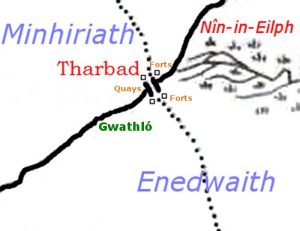Q: Do You Have a Map of Tharbad?
ANSWER: To the best of my knowledge, J.R.R. Tolkien never drew a map of Tharbad. He did, however, draw a map of Eriador on which he noted Tharbad’s approximate position, and Christopher Tolkien redrew that map.
One or more gaming companies have published detailed maps of Tharbad that are completely uncanonical, in that they devised all of the details of the city for their players. About the best we can do in terms of devising a map of Tharbad that matches what has been published by J.R.R. Tolkien and Christopher is to note the approximate locations of the causeway forts and the quays.

Like Osgiliath, the city was built around a river-spanning bridge. According to a text published in Unfinished Tales of Numenor and Middle-earth ships could navigate the river as far north as Tharbad, and that Gondor and Arnor collaborated in building the bridge, maintaining the quays and seawalls, and manning forts that guarded access to the bridge.
It may be that Tolkien intended the soldiers, mariners, and engineers to live either in the forts or on the bridge itself. It is also possible that he envisioned people living along the shore of the river, but he never indicated how many people would have lived there or where exactly they lived.
There would have been a need for farms, which (in Roman fashion) could have been maintained by the soldiers of the forts or perhaps by local farmers. Such farms would have been close to the forts, perhaps close to the shore. It would be sensible for there to be roads extending along the shores of the river to allow soldiers to patrol the approaches to the causeways and forts, but Tolkien does not say that such roads existed.
The first reference to Tharbad (derived from Sindarin thara+pata, “cross+way”) appears in the story of Aldarion and Erendis. A note says that Aldarion sailed up the Gwathló as far as Tharbad, where he met Galadriel. This part of the story was not fully written, however, and we don’t know if Tolkien intended the reference to mean “where Tharbad would later exist” or to mean that there was already a place (possibly inhabited) that had been named Tharbad in Aldarion’s day.
During the mid-Second Age the Numenoreans fortified the Gwathló river, building a series of forts along the southern shore of the river from Lond Daer Ened as far north as Tharbad. Sauron apparently ignored the greater part of these forts as he attacked Eregion and then invaded Eriador, crossing at Tharbad. Tar-Minastir’s admiral, Ciryatur, landed an army at Lond Daer Ened which then marched north along the shore of the river, attacking Sauron’s retreating forces from the rear.
The next reference to Tharbad comes after the founding of Arnor and Gondor, which jointly administered Tharbad and built or maintained the bridge and quays. Hence, Tharbad was a Dúnadan possession from at least Second Age year 3320 to Third Age year 1636. After the Great Plague Gondor withdrew its forces from Tharbad and Mordor. Tolkien does not say whether Arnor retained any forces at Tharbad after the Great Plague but all the Stoors who had been living nearby in Dunland perished.
The city was finally deserted in Third Age year 2912 after floods destroyed what remained of it. Tolkien does not say what became of its people.
See Also:
- Who Lived in Tharbad?
- Was Tharbad Ever An Independent City-state?
- Who Ruled Cardolan, Land of Red Hills?
- What Was the Capital of Cardolan?
# # #
Have you read our other Tolkien and Middle-earth Questions and Answers articles?
